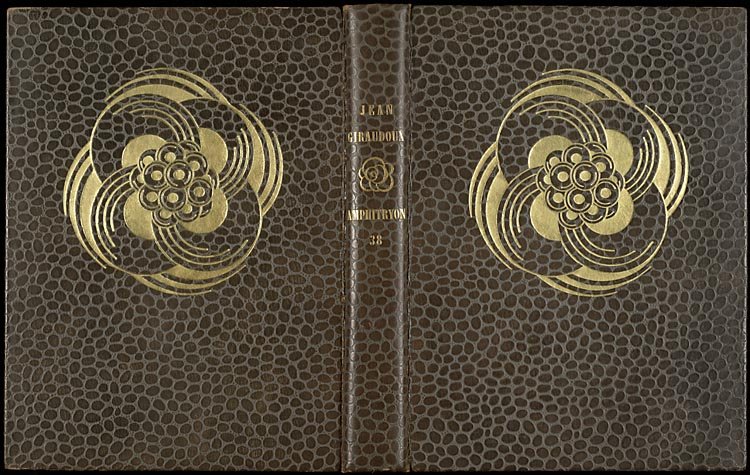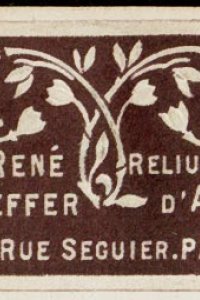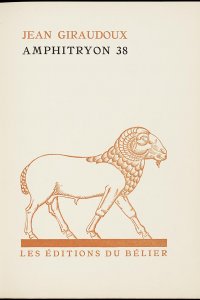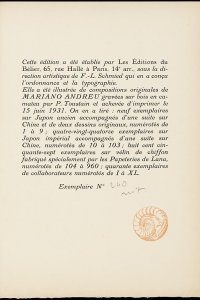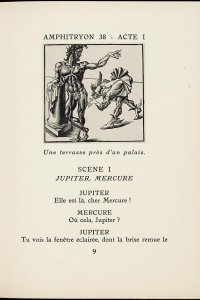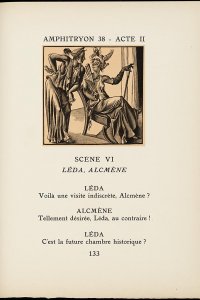Amphitryon 38 : comédie en trois actes
Year: 1931
Author: Jean Giraudoux (1882 - 1944)
Artist: Mariano Andreu (1888 - 1977)
Publisher: Bélier
Innovative play
Actor Louis Jouvet (1887-1951) owned his own theatre, the Comédie des Champs-Élysées on the Avenue Montaigne in Paris. He asked Giraudoux to write him a play. This became Siegfried, based on his novel Siegfried et le limousin from 1922. Jouvet made him rewrite it seven times, which is how Giraudoux learned how a theatrical text works. His prose was precise and full of dark suggestion, but his plays- he would ultimately write fifteen of them - were not only subtle and poetic, but also clear, ironic and direct. The reviews of his first attempt were outstanding: the French stage had finally escaped the stranglehold of naturalism, realism and psychology. Giraudoux was considered an innovative author, and his plays were performed from France to South-America, thanks to the tireless Jouvet, who was responsible for the premiere of Giraudoux' most famous play Amphitryon 38 in 1929. This work was also well received. But there were exceptions: Italian critics accused the play of blasphemy, and in France, Paul Claudel wrote that he wasn't able to finish reading the play, because it appeared to have been written by a rascal. Giraudoux himself had the impression that the praise for Amphitryon 38 went mostly to the actors: Louis Jouvet (who played Mercury), Pierre Renoir (Jupiter) and Valentine Tessier (Alcmène).
This was far from the first play about the mythological figure Amphitrion- the husband of Alcmene, who had an affair with Zeus, from which Hercules was born. Great authors such as Plautus, Molière, Dryden and Heinrich von Kleist had preceded Giraudoux, which is why he added the number 38 to the title. A professor once performed a serious investigation and concluded that Giraudoux' number was far too low. His was the umpteenth Amphitrion, but it was the first one for Giraudoux, and it became a play in which Alcmene is the actual protagonist. Hence the proposal to rename Amhitryon 38 as Alcmène I. The gods in this play are presented as human beings in everyday situations. Their divinity has been taken from them. Giraudoux himself claimed to have given Jouvet nothing but the raw material, and that Jouvet had folded his crumpled-up balls of paper into beautiful flowers. Every stage of this collaboration has been saved and documented. The staging at the premiere was a mix of Greek architecture and contemporary cubism. It was followed by a successful European tour. New sets were designed in 1934 by the famous designer A.M. Cassandre.
Wizard of colour printing
The first printed edition of Amphitryon 38 was published by Grasset in the famous green series Les cahiers verts in 1929. It was followed in 1931 by an illustrated edition from Éditions du Bélier in Paris. The lay-out and typography were designed by art deco designer and printer François-Louis Schmied (1873-1941). From 1911 onwards, he illustrated books for a series of publishers, but in 1922 Schmied established himself in the rue Hallé as illustrator, printer and publisher. He became known as the wizard of colour printing; many of his illustrations were inspired by the orient. He illustrated 35 books. The general economic crisis after 1931 also upset the book world and ended Schmied's career, although he would continue to work until 1941, thanks in part to his son Théo's engraving and printing work.
The illustrations in this edition were done by the Barcelona-born artist Mariano Andreu, who also painted opera sets and women’s portraits. Engraver Paul Toustain made wood-engravings of these original drawings, which were printed in the book on a pink background before each new act. The illustration on page 9 depicts Jupiter and Mercury, the one on page 133 shows Alcmene and Leda (the woodcuts are described in Andreu's oeuvre catalogue by Esther Garcia-Portugués).
This illustrated edition was published an edition of 1000 copies in the summer of 1931. This copy's binding was designed by René Kieffer (1875-1963), and was also produced in his studio. Kieffer made bindings in limited series, using the same design for several copies. It wasn't all made by hand. The design was printed on the binding in gold with plate stamps. The crooked stamping on the spine shows that it was serial work, an imperfection that a bookbinder who did all his work by hand would never allow. The Koopman Collection includes circa 50 Kieffer bindings.
Bibliographical description
Description: Amphitryon 38: comédie en trois actes / Jean Giraudoux ; [ill. par Mariano Andreu]. - Paris : Bélier, 1931. - 213 p. : ill. ; 27 cm
1st edition: 1929
Edition: 960 copies
This copy: Number 240 of 857 on Lana
Bookbinder: René Kieffer (Parijs)
Bibliography: Carteret IV-185 ; Monod 5437
Shelfmark: Koopm A 22
References
- Philippe Dufay, Jean Giraudoux: biographie. Paris, Julliard, 1993
- Esther García-Portugués, Mariano Andreu (1888-1979). Biografía y catálogo razonado. Barcelona, ArsNostrums Edicions, 2019
- Jean Giraudoux, du réel à l’imaginaire. Paris: Bibliothèque Nationale, 1982
- Louis Jouvet, Notes et documents. Paris, Perrin, 1952
- Bettina Liebowitz Knapp, 'Jouvet and Giraudoux 1928-1934', in: Louis Jouvet, man of the theatre. New York, Columbia University Press, 1957
- Paul A. Mankin, Precious irony: The theatre of Jean Giraudoux. The Hague, Mouton, 1971
- Maurice Martin du Gard, Les mémorables, 1918-1945. Paris, Gallimard, 1999
